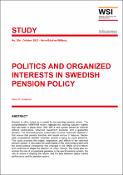Options
Politics and Organized Interests in Swedish Pension Policy
Author(s)
Date Issued
2021-10
Date Available
2024-08-15T16:03:13Z
Abstract
Sweden is often hailed as a model for far-reaching pension reform. The comprehensive 1994/1998 reform replaced the existing statutory system that had been in place since 1960 with a new system based on notional defined contributions, individual investment accounts, and a guarantee pension. The reformed pension system also includes “automatic stabilizers” that ensure that pension liabilities and assets remain in balance. Sectorwide occupational pension schemes provide a topup to public pensions. This study analyses the origins, negotiation, and effects of the reformed pension system. It discusses the weaknesses of the preexisting system and the broad political compromise that emerged in the 1990s around reform and continues to shape the direction of policy change. The study also examines the role of occupational pensions in the overall pension system, the role of unions in shaping the reform, and the links between labour market performance and the pension system.
Other Sponsorship
Institute of Economic and Social Research
Type of Material
Technical Report
Publisher
Institute of Economic and Social Research
Series
WSI Study
28e
Language
English
Status of Item
Peer reviewed
ISSN
2367-0827
This item is made available under a Creative Commons License
File(s)
Loading...
Name
p_wsi_studies_28e_2021.pdf
Size
456.14 KB
Format
Adobe PDF
Checksum (MD5)
29c71363bb86a48826c3fb31a8c7697b
Owning collection